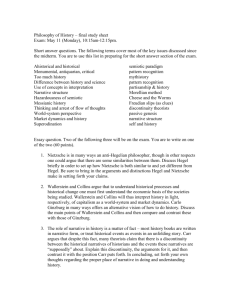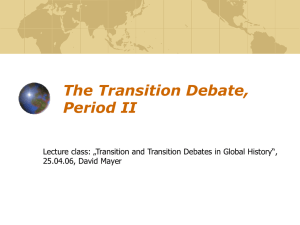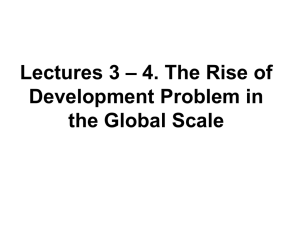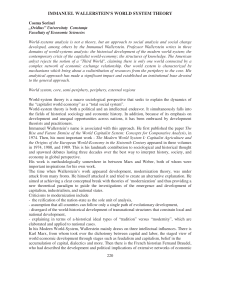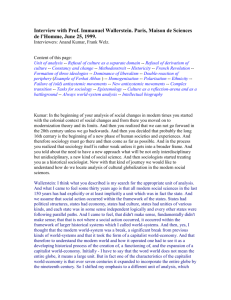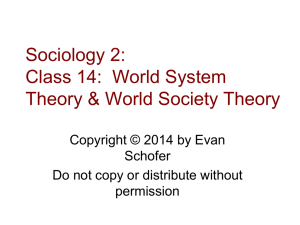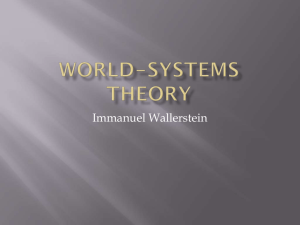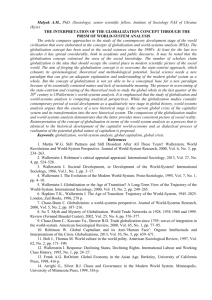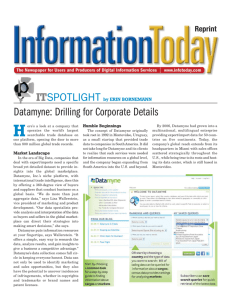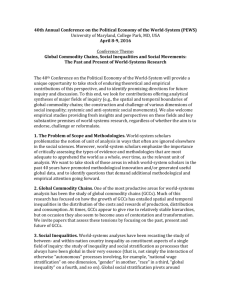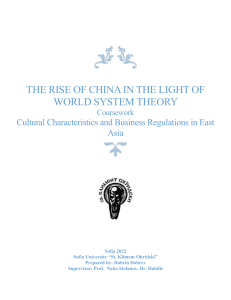Wallerstein
advertisement
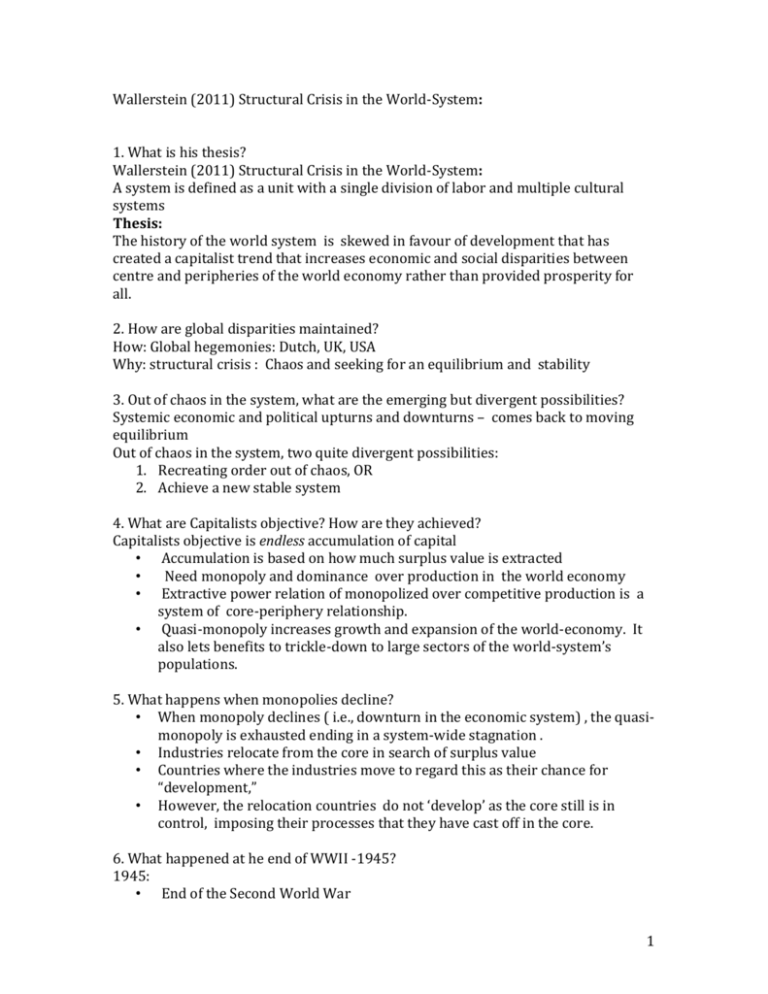
Wallerstein (2011) Structural Crisis in the World-System: 1. What is his thesis? Wallerstein (2011) Structural Crisis in the World-System: A system is defined as a unit with a single division of labor and multiple cultural systems Thesis: The history of the world system is skewed in favour of development that has created a capitalist trend that increases economic and social disparities between centre and peripheries of the world economy rather than provided prosperity for all. 2. How are global disparities maintained? How: Global hegemonies: Dutch, UK, USA Why: structural crisis : Chaos and seeking for an equilibrium and stability 3. Out of chaos in the system, what are the emerging but divergent possibilities? Systemic economic and political upturns and downturns – comes back to moving equilibrium Out of chaos in the system, two quite divergent possibilities: 1. Recreating order out of chaos, OR 2. Achieve a new stable system 4. What are Capitalists objective? How are they achieved? Capitalists objective is endless accumulation of capital • Accumulation is based on how much surplus value is extracted • Need monopoly and dominance over production in the world economy • Extractive power relation of monopolized over competitive production is a system of core-periphery relationship. • Quasi-monopoly increases growth and expansion of the world-economy. It also lets benefits to trickle-down to large sectors of the world-system’s populations. 5. What happens when monopolies decline? • When monopoly declines ( i.e., downturn in the economic system) , the quasimonopoly is exhausted ending in a system-wide stagnation . • Industries relocate from the core in search of surplus value • Countries where the industries move to regard this as their chance for “development,” • However, the relocation countries do not ‘develop’ as the core still is in control, imposing their processes that they have cast off in the core. 6. What happened at he end of WWII -1945? 1945: • End of the Second World War 1 End of an intense 30-year-long struggle between the United States and Germany begun in the 1870s • It was a conflict to succeed Great Britain as the hegemonic power of the world-system. 1945-1967/73 : Conservatives systematically started to change the worldsystem ‘s characteristics and its direction • 7. What trend and policies began during the 1970s? What are its characteristics? 1970s on: Unleashed neo liberalism • Dismantled all advances in social welfare and public ‘s share of the wealth • Reduced real wages worldwide • Restrained the forces that would have pressured producers to internalize the costs of combating damage to the world's ecology • Conservatives reduced the welfare state or eliminated its benefits. This program was called 8. Since the 1970s, what shift occurred in capitalism? • 1945-1970 was one of great economic expansion based on production in the world-economy • Since the 1970s, shift from production to financial capitalism. • The world-system then entered the most extensive continuous series of speculative bubbles in the history of the modern world-system, resulting in heavy sovereign and individual debts. 9. What trend in government emerged in the 1980s? • Rise of neo-conservative governments: 1979: Margaret Thatcher 1980: Election of Ronald Reagan in 1980, • In the U.S., the neo-cons wanted to get back their grip on the sliding hegemonic dominance through ‘unilateral macho militarism’ . • Pressured their Western European allies to adhere to US policies 10. What replaced the term ‘development’ and with what consequences? “Globalization” replaced the previous buzzword “development… Washington Consensus… Conservatives in the world move to reduce all the major costs of production International Monetary Fund, backed by the U.S. Treasury, imposed adherence to neoliberal conditions as a condition of all financial assistance to countries with budgetary crises. By the mid-1990s, a significant popular resistance to the Washington Consensus arose. 11. What is a hegemonic power? What is its objective? Who are and were the hegemons through history? 2 A hegemonic power is a quasi-monopoly of geopolitical power The hegemon (e.g., U.S. in 20th C) , is able to impose its system of order and rules world wide This favors the maximization of accumulation of capital to enterprises located within its borders. In 500 years of world history, three hegemons arose and fell: Mid 17th C : (Dutch Republic) i.e., United Provinces Mid 19th C: the United Kingdom Mid 20th C United States Hegemonies have lasted, on average, only twenty-five years. Quasi-monopolies of geopolitical power are self-liquidating 12. What is happening to the global profits when emerging economies started growing? • Increases in the living standards of segments of the populations in BRIC countries due to their share of the surplus value in the global economy, • This spreading of profits diluted the regular profits going to the Core’s capitalists. • Also strained the existing world resources 13. What is Club of Davos as distinct from Club of Porto Alegre? Rise of new clubs of the Core vis-à-vis the peripheries: • Club of Davos wish to co-opt the proponents of transformation by fake signs of progress (such as “green capitalism” or “poverty reduction”). Club of Porto Alegre: a reconstructed world that is horizontal and decentralized in its organization, and insist on the rights of groups as well as of individuals 14. What are Wallerstein’s solutions to the financial and economic crisis? Wallerstein’s solutions to the financial and economic crises: • Reject economic growth goals • Pursue decommodification • Reverse the last 30 years of commodification of public resources— education, health, water and air • Increase decommodification by including other productions: agriculture and industries • Establish self-sufficient local and regional groups of activities serving the basic needs life, e.g., food and shelter • “Alterglobalization” of multiple autonomies that interconnect 3
